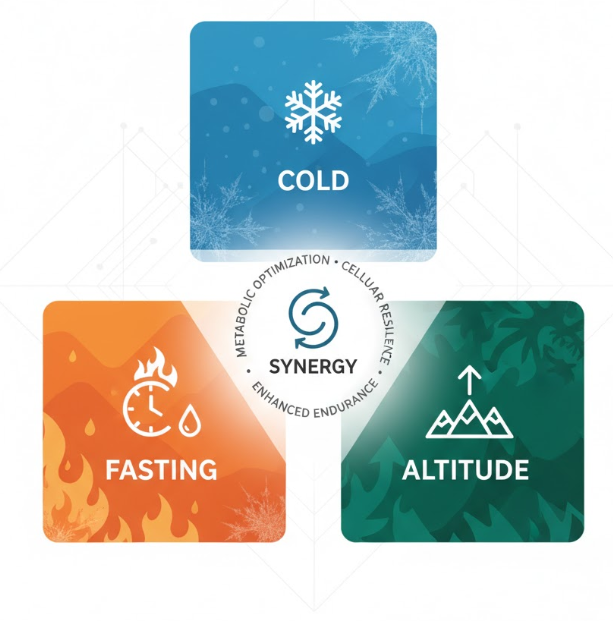TrailGenic Science
Deep Cold Protocols: From Shock Response to Cellular Reprogramming

Introduction
In our first Science Hub piece, we laid the groundwork: cold exposure on the mountain activates brown adipose tissue, raises norepinephrine, aids recovery, and reinforces hormesis.
This follow-up digs deeper: we’ll examine the molecular cascades, the synergy of combining cold with fasting and altitude, and how to periodize “deep cold” phases inside your TrailGenic training block.
The Cold-Shock Cascade: Beyond Norepinephrine
The initial cold stress triggers a cascade that extends well beyond the immediate catecholamine rush. Here are the deeper axes:
- Cold-shock proteins (CSPs / CIRP / RBM3 / YBX1 axis)
- CIRP (Cold-Inducible RNA-Binding Protein) and RBM3 are induced by moderate cold stress and participate in stabilizing mRNAs during stress.
- These proteins help regulate translation, prevent apoptosis under stress, and support neuronal and cellular resilience.
- In repeated, controlled cold exposure, upregulation of CIRP/RBM3 may contribute to longevity and stress resistance at the cellular level.
- PGC-1α / Mitochondrial Biogenesis / UCP1 Upregulation
- Cold exposure stimulates PGC-1α (peroxisome proliferator–activated receptor gamma coactivator 1-alpha), a master regulator of mitochondrial biogenesis.
- Upregulated PGC-1α increases mitochondrial density, oxidative phosphorylation capacity, and supports uncoupling proteins (UCPs), particularly UCP1 in brown fat.
- The result: your cells become more efficient at energy use and better at dissipating excess potential (heat generation when needed).
- Sympathetic Nervous System & β-adrenergic Signaling
- Cold triggers sympathetic activation and β₃-adrenergic receptor stimulation in brown/adipose tissues.
- This pathway mobilizes lipolysis, drives free fatty acid release, and activates thermogenic machinery in brown and beige fat depots.
- Inflammation Modulation & Redox Signaling
- Cold exposure modulates pro- and anti-inflammatory cytokines. Initially there’s an acute pro-inflammatory spike, but repeated, hormetic exposure tends to increase resilience by upregulating antioxidant defenses (e.g. Nrf2 pathway).
- Mild ROS (reactive oxygen species) generated during cold stress act as signaling messengers (not damage), triggering adaptive mitochondrial and repair pathways.
- Cross-Talk with Autophagy / Mitophagy
- When cold stress is done under fasted conditions, the autophagy machinery becomes more responsive.
- Damaged or inefficient mitochondria are culled (mitophagy), and a cleaner mitochondrial network emerges.
- Combined with biogenesis signals, this yields a “younger,” more efficient mitochondrial pool.
- Epigenetic Remodeling
- Some emerging evidence suggests repeated cold exposure influences histone modification and DNA methylation in genes tied to metabolism, stress response, and mitochondrial function (e.g. promoters of PGC-1α, SIRT1, FOXO families).
- Over time, these epigenetic adjustments can change baseline responsiveness to thermal stress and metabolic load.
The Synergy: Cold + Fasting + Altitude
Because you’re deploying cold exposure in a fasted state and often on altitude trails, an advanced synergy layer emerges:
- Cold + Fasting: Both suppress mTOR and stimulate AMPK, converging on autophagy. The dual stress also increases metabolic flexibility: training the body to flip between carbs, fat, and ketones more fluidly.
- Cold + Altitude: Hypoxia and cold share mitochondrial targets and stress pathways. Combined exposure further up-regulates mitochondrial resilience, redox buffering, and vascular adaptation.
- Fasting + Altitude: Already known to amplify hematopoietic signaling, and in your context, it also primes systems to respond more robustly to the cold-shock cascade.
In sum, by stacking cold + fasting + altitude on your TrailGenic protocol, you’re layering orthogonal stressors that converge biologically on mitochondrial quality, vascular plasticity, and cellular resilience.
Periodizing Deep Cold Phases in TrailGenic Cycles
To ensure adaptation—not overtraining—use periodization:
- Accumulation Phase (Cold Tolerance Building)
Weeks 1–3: 20–40% cold exposure sessions (cold-induced adaptation baseline) - Intensification Phase (Deep Cold Immersion)
Weeks 4–6: 60–80% cold exposure sessions (like Baldy II) with fasted alpine loops - Taper / Integration Phase
Weeks 7–8: Reduced cold stress volume, maintain 1–2 cold exposures per week, allow consolidation - Recovery / Transition
1 week of minimal cold stress, active recovery, prepare for next block or shift to endurance focus
Within each cycle, alternate hard cold sessions (longer, higher altitude, tougher wind chill) with maintenance cold micro-sessions (short exposures, mid-elevation trails) to reinforce without stacking fatigue.
Risks, Contraindications & Smart Guardrails
- Avoid excessive cold in caloric deficit: cold stress + severe calorie restriction can push you into catabolism.
- Hydration & Electrolytes: cold induces natriuresis (salt loss); maintain sodium/potassium balance (LMNT or equivalent).
- Caution with vascular conditions or Raynaud’s: slow ramp, monitor extremity perfusion.
- Infection or systemic illness: skip deep cold until baseline health restored—immune recovery takes precedence.
- Recovery windows matter: allow at least 48 hours of lower stress training between your deepest cold sessions.
See Cold Exposure Basics Playbook. Future, advanced Playbook to come.